Habitat Characteristics and Mineral Nutrition Status of Rubus chamaemorus L. in Latvia
Abstract
1. Introduction
2. Results
2.1. Growing Conditions and Surrounding Vegetation Composition
2.2. Mineral Nutrition of Wild Cloudberries
3. Discussion
3.1. Habitat Characteristics
3.2. Mineral Nutrition Status
4. Materials and Methods
4.1. Inspection in Natural Habitats
4.2. Phytosociological Records
4.3. Nutrient Analysis
4.4. Statistical Analysis
5. Conclusions
Author Contributions
Funding
Institutional Review Board Statement
Informed Consent Statement
Data Availability Statement
Conflicts of Interest
References
- Wiersum, K.F. New interest in wild forest products in Europe as an expression of biocultural dynamics. Hum. Ecol. 2017, 45, 787–794. [Google Scholar] [CrossRef] [PubMed]
- Thiem, B. Rubus chamaemorus L.—A Boreal Plant Rich in Biologically Active Metabolites: A Review. Biol. Lett. 2003, 40, 3–13. [Google Scholar]
- Bellemare, M.; Lapointe, L.; Chiasson, G.; Daigle, J.-Y.; Rochefort, L. Conditions favouring survival of cloudberry (Rubus chamaemorus) rhizomes planted in cutover peatland. Mires Peat 2009, 5, 1–8. [Google Scholar]
- Østgård, O. Investigations on Cloudberries (Rubus chamaemorus L.) in North-Norway. Forsk. Og I Landbr. 1964, 15, 409–444. [Google Scholar]
- Taylor, K. Rubus chamaemorus L. J. Ecol. 1971, 59, 293. [Google Scholar] [CrossRef]
- Kortesharju, J. Ecological Factors Affecting the Ripening Time of Cloudberry (Rubus chamaemorus) Fruit under Cultivation Conditions. Ann. Bot. Fenn. 1993, 30, 263–274. [Google Scholar]
- Martinussen, I.; Rapp, K.; Bhuvaneswari, T.V.; Junttila, O. Flower development in cloudberry (Rubus chamaemorus L.). Acta Hortic. 2002, 585, 143–147. [Google Scholar] [CrossRef]
- Théroux Rancourt, G.; Rochefort, L.; Lapointe, L. Cloudberry cultivation in cutover peatlands: Hydrological and soil physical impacts on the growth of different clones and cultivars. Mires Peat 2009, 5, 1–16. [Google Scholar]
- Rapp, K. Cloudberry Growers Guide; North Norwegian Centre for Research and Rural Development: Tromsø, Norway, 2004. [Google Scholar]
- Latvijas daba. Lācene Rubus chamaemorus L. Available online: https://www.latvijasdaba.lv/augi/rubus-chamaemorus-l/ (accessed on 23 September 2022).
- Karst, A.L.; Antos, J.A.; Allen, G.A. Sex ratio, flowering and fruit set in dioecious Rubus chamaemorus (Rosaceae) in Labrador. Botany 2008, 86, 204–212. [Google Scholar] [CrossRef]
- Brown, A.O.; McNeil, J.N. Pollination ecology of the high latitude, dioecious cloudberry (Rubus chamaemorus; Rosaceae). Am. J. Bot. 2009, 96, 1096–1107. [Google Scholar] [CrossRef]
- Metzing, D.; Garve, E.; Matzke-Hajek, G.; Adler, J.; Bleeker, W.; Breunig, T.; Caspari, S.; Dunkel, F.G.; Fritsch, R.; Gottschlich, G.; et al. Rote Liste Und Gesamtartenliste Der Farn- Und Blütenpflanzen (Trachaeophyta) Deutschlands. In Rote Liste Gefährdeter Tiere, Pflanzen Und Pilze Deutschlands. Band 7: Pflanzen; Metzing, D., Hofbauer, N., Ludwig, G., Matzke-Hajek, G., Eds.; Landwirtschaftsverlag: Münster, Germany, 2018; Volume 70, pp. 13–358. [Google Scholar]
- Koczur, A. Newly Discovered Relic Population of Rubus chamaemorus L. in the Western Carpathians. Acta Soc. Bot. Pol. 2011, 73, 129–133. [Google Scholar] [CrossRef]
- Kaplan, Z.; Danihelka, J.; Chrtek, J.; Prančl, J.; Ducháček, M.; Ekrt, L.; Kirschner, J.; Brabec, J.; Zázvorka, J.; Trávníček, B.; et al. Distributions of Vascular Plants in the Czech Republic. Part 7. Preslia 2018, 90, 425–531. [Google Scholar] [CrossRef]
- Laiviņš, M.; Bice, M.; Krampis, I.; Knape, D.; Šmite, D.; Šulcs, V. Latvijas Kokaugu Atlants; Institute of Biology of the University of Latvia: Riga, Latvia, 2009; p. 476. [Google Scholar]
- Martinussen, I.; Uleberg, E.; McDougall, G.J.; Stewart, D.; Junttila, O. Development and quality of cloudberry (Rubus chamaemorus L.) as affected by female parent, male parent and temperature. J. Berry Res. 2010, 1, 92–101. [Google Scholar] [CrossRef]
- Bārdule, A.; Jūrmalis, E.; Lībiete, Z.; Pauliņa, I.; Donis, J.; Treimane, A. Use of retail market data to assess prices and flows of non-wood forest products in Latvia. Silva Fenn. 2020, 54, 10341. [Google Scholar] [CrossRef]
- Ferlemi, A.V.; Lamari, F. Berry Leaves: An Alternative Source of Bioactive Natural Products of Nutritional and Medicinal Value. Antioxidants 2016, 5, 17. [Google Scholar] [CrossRef] [PubMed]
- Pajari, A.-M.; Päivärinta, E.; Paavolainen, L.; Vaara, E.; Koivumäki, T.; Garg, R.; Heiman-Lindh, A.; Mutanen, M.; Marjomäki, V.; Ridley, A.J. Ellagitannin-Rich Cloudberry Inhibits Hepatocyte Growth Factor Induced Cell Migration and Phosphatidylinositol 3-Kinase/AKT Activation in Colon Carcinoma Cells and Tumors in Min Mice. Oncotarget 2016, 7, 43907–43923. [Google Scholar] [CrossRef] [PubMed]
- Hykkerud, A.L.; Uleberg, E.; Hansen, E.; Vervoort, M.; Mølmann, J.; Martinussen, I. Seasonal and Yearly Variation of Total Polyphenols, Total Anthocyanins and Ellagic Acid in Different Clones of Cloudberry (Rubus chamaemorus L.). J. Appl. Bot. Food Qual. 2018, 91, 96–102. [Google Scholar] [CrossRef]
- Li, J.; Percival, D.; Hoyle, J.; Yue, J.; White, J.; Head, K.; Pruski, K. Environmental Effects on Fruit Composition of Cloudberry/Bakeapple (Rubus chamaemorus L.) Grown in Southern Labrador, Canada. Can. J. Plant Sci. 2015, 95, 1167–1175. [Google Scholar] [CrossRef]
- Karofeld, E.; Jarašius, L.; Priede, A.; Sendžikaitė, J. On the After-Use and Restoration of Abandoned Extracted Peatlands in the Baltic Countries: Extracted Peatlands in Baltics. Restor. Ecol. 2017, 25, 293–300. [Google Scholar] [CrossRef]
- Bušs, K. Meža Ekoloģija un Tipoloģija; Zinātne: Riga, Latvia, 1981. [Google Scholar]
- Laiviņš, M. Highest Syntaxonomic Units of Plant Communities of Latvia; Latvian mire vegetation classification and dynamics: Scientific articles; University of Latvia: Riga, Latvia, 1998; Volume 613, pp. 7–22. [Google Scholar]
- Laiviņš, M. Latvia’s forest tree and shrub plant communities and biotopes. Mežzinātne 2014, 28, 6–38. [Google Scholar]
- ASTM D 4427-13; Standard classification of peat samples by laboratory testing. Annual Book of ASTM Standards; ASTM International: West Conshohocken, PA, USA, 2013; Volume 04.08. [Google Scholar]
- Hart, J.; Strik, B.C.; Rempel, H. Caneberries. In Nutrient Management Guide EM8903-E; Oregon State University: Corvallis, OR, USA, 2006. [Google Scholar]
- Nollendorfs, V. Highbush blueberry soil and fertilization demands. Agropols 2004, 12, 8–10. [Google Scholar]
- Osvalde, A. Amerikas lielogu dzērveņu mēslošanas īpatnības. In Fruit Growing; Ikase, L., Ed.; LV Augļkopības institūts: Dobele, Latvia, 2015; pp. 415–417. [Google Scholar]
- Bussières, J.; Rochefort, L.; Lapointe, L. Cloudberry Cultivation in Cutover Peatland: Improved Growth on Less Decomposed Peat. Can. J. Plant Sci. 2015, 95, 479–489. [Google Scholar] [CrossRef]
- Prieditis, N. Evaluation frameworks and conservation system of Latvian forests. Biodivers. Conserv. 2002, 11, 1361–1375. [Google Scholar] [CrossRef]
- Pakalne, M.; Kalnina, L. Mire ecosystems in Latvia. Stapfia 2005, 85, 147–174. [Google Scholar]
- State Forest Service. Forest Management. Available online: https://www.vmd.gov.lv/valsts-meza-dienests/statiskas-lapas/-meza-apsaimniekosana-?nid=1472#jump (accessed on 23 October 2022).
- Kachanovsky, I.M. (Ed.) . The Red Book of the Republic of Belarus: Plants: The Rare and Endangered Species of Wild Plants; Belarusian Encyclopedia Named After P. Brovka: Minsk, Belarus, 2015; p. 445. [Google Scholar]
- Antala, M.; Juszczak, R.; van der Tol, C.; Rastogi, A. Impact of Climate Change-Induced Alterations in Peatland Vegetation Phenology and Composition on Carbon Balance. Sci. Total Environ. 2022, 827, 154294. [Google Scholar] [CrossRef]
- Boulanger, Y.; Taylor, A.R.; Price, D.T.; Cyr, D.; McGarrigle, E.; Rammer, W.; Sainte-Marie, G.; Beaudoin, A.; Guindon, L.; Mansuy, N. Climate Change Impacts on Forest Landscapes along the Canadian Southern Boreal Forest Transition Zone. Landsc. Ecol. 2017, 32, 1415–1431. [Google Scholar] [CrossRef]
- Latvian Peat Association. Peat Extraction. Available online: http://www.latvijaskudra.lv/en/Interesting_information/ (accessed on 26 October 2022).
- Latvijas Republikas Saeima. Law on Forests. Available online: https://likumi.lv/ta/en/en/id/2825-law-onforests (accessed on 5 November 2022).
- Marks, T.C.; Taylor, K. The Mineral Nutrient Status of Rubus chamaemorus L. in Relation to Burning and Sheep Grazing. J. Appl. Ecol. 1972, 9, 501–511. [Google Scholar] [CrossRef]
- Ågren, J. Sexual differences in biomass and nutrient allocation in the dioecious Rubus chamaemorus. Ecology 1988, 69, 962–973. [Google Scholar] [CrossRef]
- Parent, L.E.; Parent, S.-É.; Hébert-Gentile, V.; Naess, K.; Lapointe, L. Mineral balance plasticity of cloudberry (Rubus chamaemorus) in Quebec-Labrador bogs. Am. J. Plant Sci. 2013, 4, 1508–1520. [Google Scholar] [CrossRef]
- Osvalde, A.; Karlsons, A.; Pormale, J.; Nollendorfs, V. Renovation of extracted high bogs in Latvia: Mineral nutrition and ecological aspects of American cranberry cultivation. Anadolu J. Agric. Sci. 2010, 25 (Suppl. S2), 120–125. [Google Scholar]
- Pormale, J.; Osvalde, A.; Nollendorfs, V. Comparison study of cultivated highbush and wild blueberry nutrient status in producing plantings and woodlands, Latvia. Latv. J. Agron. 2009, 12, 80–87. [Google Scholar]
- Zhou, J.; Desjardins, Y.; Lapointe, L. Nutrient uptake kinetics of cloudberry. J. Plant Nutr. 2013, 36, 1219–1233. [Google Scholar] [CrossRef]
- Pritts, M.; Heidenreich, C.; McDermott, L.; Miller, J. (Eds.) Berry Soiland Nutrient Management—A Guide for Educators and Growers; Cornell University: Ithaca, NY, USA, 2015. [Google Scholar]
- Hart, J.; Strik, B.; White, L.; Yang, W. Nutrient Management for Blueberries in Oregon. In Nutrient Management Guide EM 8918; Oregon State University: Corvallis, OR, USA, 2006. [Google Scholar]
- Bryla, D.R.; Strik, B. Nutrient Requirements, Leaf Tissue Standards, and New Options for Fertigation of Northern Highbush Blueberry. HortTechnology 2015, 25, 464–470. [Google Scholar] [CrossRef]
- Boulanger-Pelletier, J.; Lapointe, L. Fertilization stimulates root production in cloudberry rhizomes transplanted in a cutover peatland. Can. J. Plant Sci. 2017, 97, 1046–1056. [Google Scholar] [CrossRef]
- Hébert-Gentile, V.; Naess, S.K.; Parent, L.E.; Lapointe, L. Organo-mineral fertilization in natural peatlands of the Quebec North-Shore, Canada: Dispersion in soil and effects on cloudberry growth and fruit yield. Acta Agric. Scand. Sect. B-Soil Plant Sci. 2011, 61, 8–17. [Google Scholar] [CrossRef]
- Marschner, P. (Ed.) Mineral Nutrition of Higher Plants, 3rd ed.; Academic Press: London, UK, 2012. [Google Scholar]
- Fageria, N.K.; Moreira, A. The role of mineral nutrition on root growth of crop plants. In Advances in Agronomy; Donald, L.S., Ed.; Elsevier Academic Press Inc.: San Diego, CA, USA, 2011; pp. 251–331. [Google Scholar]
- Aerts, R.; Chapin, F.S., III. The Mineral Nutrition of Wild Plants Revisited: A Re-Evaluation of Processes and Patterns. Adv. Ecol. Res. 1999, 30, 1–67. [Google Scholar] [CrossRef]
- Jonard, M.; Legout, A.; Nicolas, M.; Dambrine, E.; Nys, C.; Ulrich, E.; van der Perre, R.; Ponette, Q. Deterioration of Norway spruce vitality despite a sharp decline in acid deposition: A long-term integrated perspective. Glob. Change Biol. 2012, 18, 711–725. [Google Scholar] [CrossRef]
- Karlsons, A.; Osvalde, A.; Čekstere, G.; Pormale, J. Research on the Mineral Composition of Cultivated and Wild Blueberries and Cranberries. Agron. Res. 2018, 16, 454–463. [Google Scholar] [CrossRef]
- Kessel, C. Fertilizing raspberries—Raspberry leaf analysis. Fruit Prod. Recomm. 2003, 360, 1–3. [Google Scholar]
- Strik, B.; Bryla, D.R. Uptake and Partitioning of Nutrients in Blackberry and Raspberry and Evaluating Plant Nutrient Status for Accurate Assessment of Fertilizer Requirements. HortTechnology 2015, 25, 452–459. [Google Scholar] [CrossRef]
- Brdar-Jokanović, M. Boron toxicity and deficiency in agricultural plants. Int. J. Mol. Sci. 2020, 21, 1424. [Google Scholar] [CrossRef] [PubMed]
- Peatland Ecology Research Group. Production of Berries in Peatlands. In Guide Produced under the Supervision of Line Rochefort and Line Lapointe; Université Laval: Quebec, QC, Canada, 2009; pp. 3–43. [Google Scholar]
- SLLC. Latvian Environment, Geology and Meteorology Centre. Latvijas Klimats. Available online: https://Videscentrs.Lvgmc.Lv/Lapas/Latvijas-Klimats (accessed on 15 October 2022).
- Braun-Blanquet, J. Plant Sociology; Fuller, G.D.; Conrad, H.S., Translators; McGraw-Hill: New York, NY, USA, 1932. [Google Scholar]
- Cekstere, G.; Osvalde, A.; Elferts, D.; Rose, C.; Lucas, F.; Vollenweider, P. Salt accumulation and effects within foliage of Tilia × vulgaris trees from the street greenery of Riga, Latvia. Sci. Total Environ. 2020, 747, 140921. [Google Scholar] [CrossRef] [PubMed]
- Agilent Technologies. Microwave Plasma Atomic Emission Spectroscopy (MP-AES). Application eHandbook. Available online: https://www.agilent.com/cs/library/applications/5991-7282EN_MP-AES-eBook.pdf (accessed on 10 October 2022).
- Bridgham, S.; Lamberti, G. Ecological Dynamics III: Decomposition in Wetlands. In The Wetlands Handbook; Maltby, E., Barker, T., Eds.; Wiley-Blackwell: Oxford, UK, 2009; p. 336. [Google Scholar] [CrossRef]
- R Core Team. R: A Language and Environment for Statistical Computing; R Foundation for Statistical Computing: Vienna, Austria, 2022; Available online: https://www.r-project.org/ (accessed on 27 October 2022).
- Wickham, H.; François, R.; Henry, L.; Müller, K.D. Dplyr: A Grammar of Data Manipulation. Available online: https://dplyr.tidyverse.org (accessed on 27 October 2022).
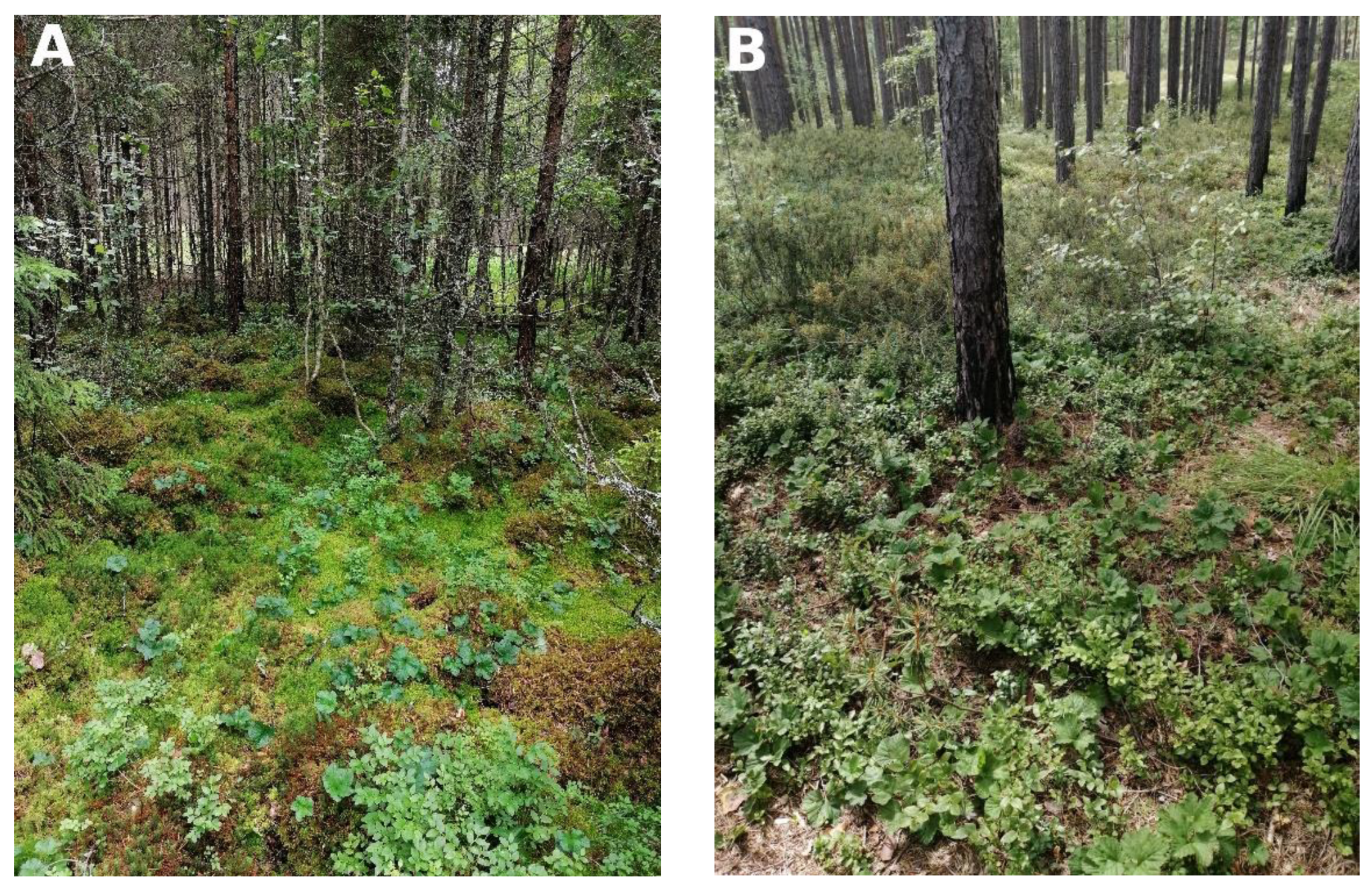
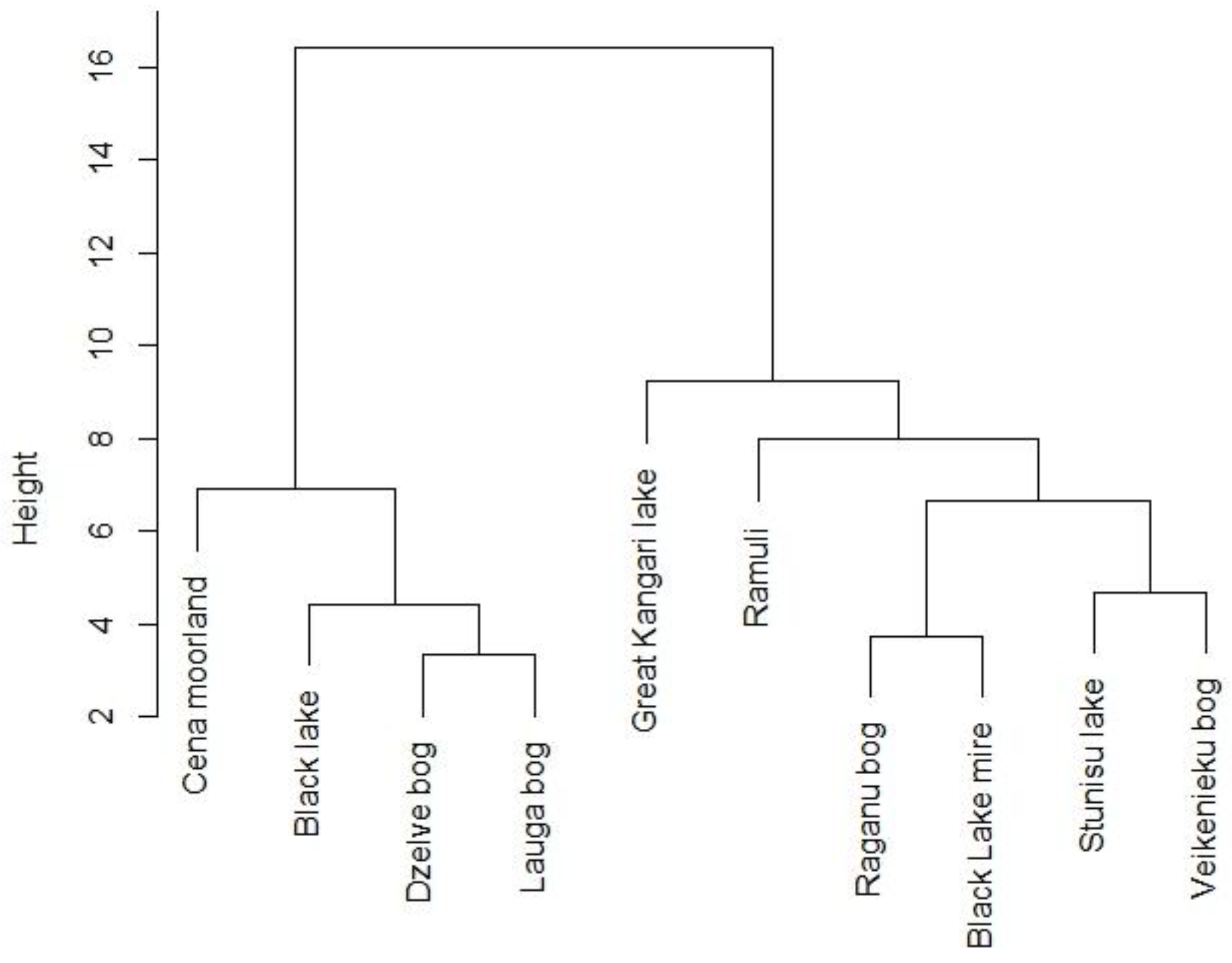
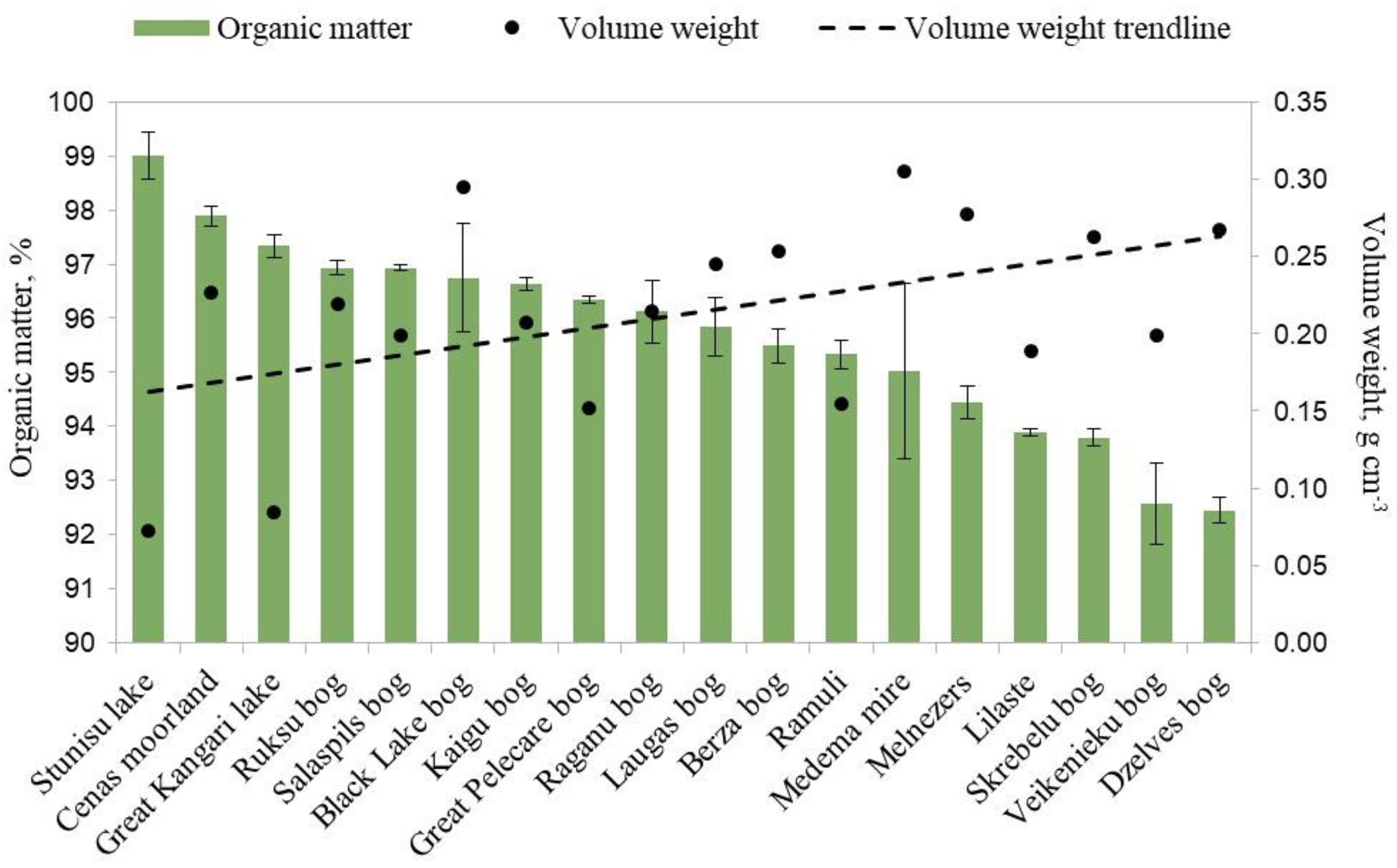
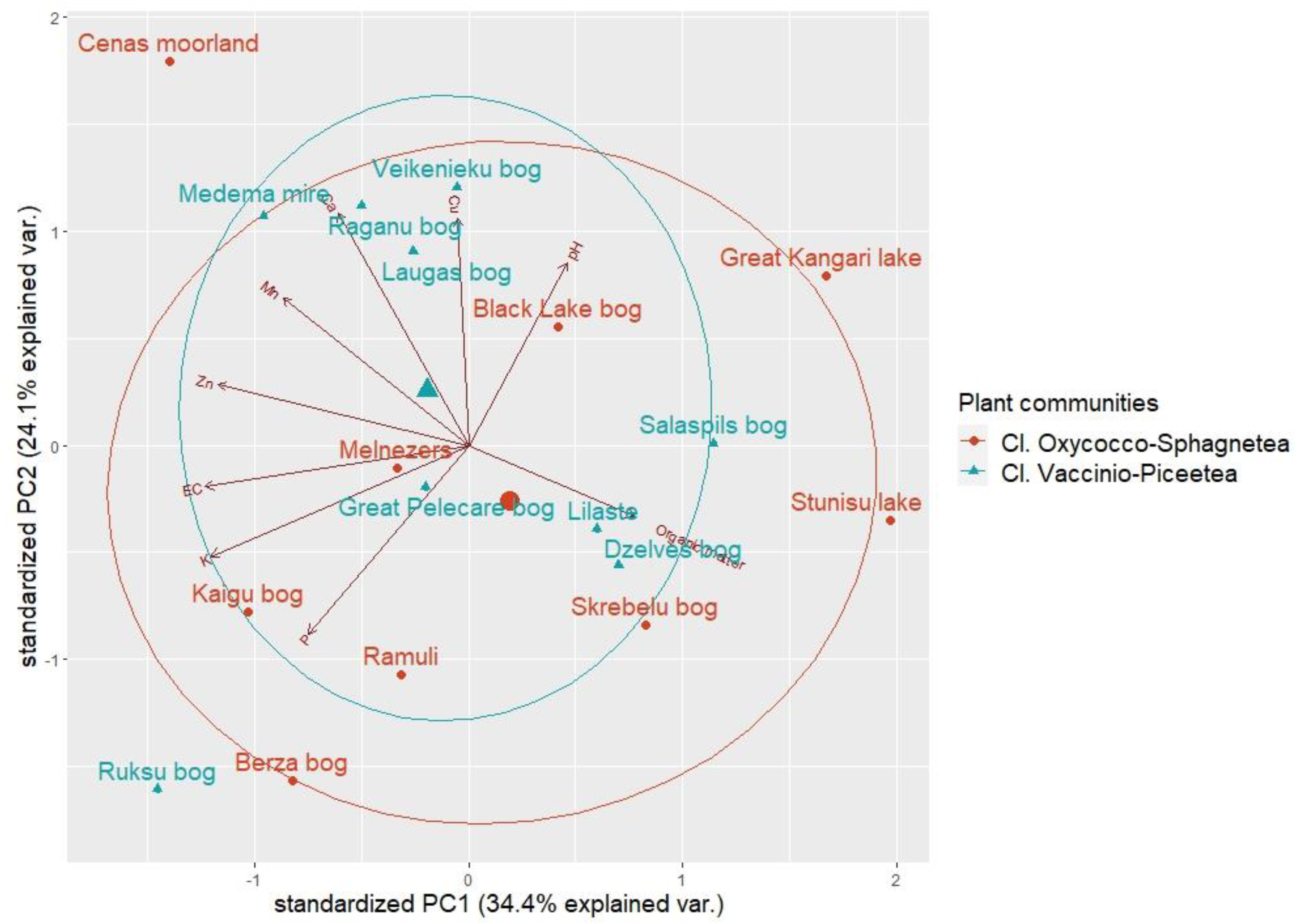
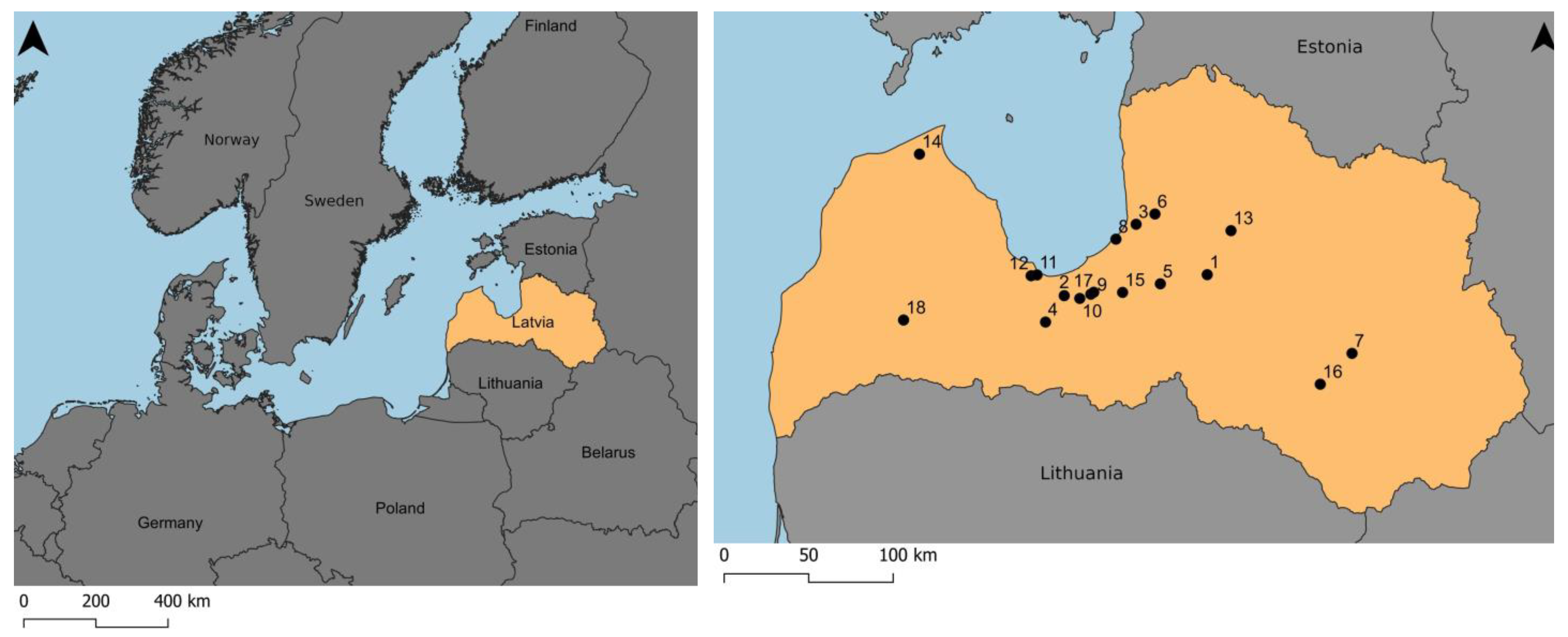

| Cover | Study Site | |||||||||
|---|---|---|---|---|---|---|---|---|---|---|
| Cena Moorland | Dzelve bog | Great Kangari Lake | Lauga bog | Black Lake mire | Melnezers | Raganu bog | Ramuli | Stunisu Lake | Veiukenieku bog | |
| Tree layer, % | - | - | - | - | - | - | - | - | - | - |
| Shrub layer, % | 5 | - | - | - | 2 | 1 | 2 | 20 | 10 | 15 |
| Herb layer, % | 50 | 50 | 65 | 30 | 65 | 60 | 40 | 25 | 55 | 25 |
| Bryophytes/lichen layer, % | 20 | 60 | 30 | 25 | 35 | 30 | 55 | 60 | 25 | 65 |
| Without vegetation, % | 35 | - | 5 | 55 | 5 | 30 | 10 | - | 15 | 5 |
| Shrubs | ||||||||||
| Betula pubescens | - | - | - | - | - | - | - | - | - | 1 |
| Pinus sylvestris | - | - | - | - | - | 1 | 1 | - | - | - |
| Herbaceous | ||||||||||
| Andromeda polifolia | 1 | - | 3 | - | 4 | - | 5 | - | 5 | 3 |
| Betula pubescens | - | - | - | - | 2 | - | 1 | - | - | 2 |
| Calluna vulgaris | 5 | - | - | - | 5 | - | 5 | - | 2 | 4 |
| Carex lasiocarpa | - | - | - | - | 2 | 1 | 2 | 5 | 4 | 5 |
| Carex nigra | - | - | - | - | 1 | - | - | - | - | 2 |
| Drosera anglica | - | - | - | - | - | - | - | - | 2 | - |
| Empetrum nigrum | 1 | - | 2 | - | - | - | - | - | - | - |
| Ledum palustre | 3 | 5 | - | - | 2 | 2 | 1 | - | 3 | 5 |
| Lycopodium annotinum | - | - | - | - | - | - | - | - | - | 2 |
| Melampyrum pratense | 2 | - | 2 | - | - | 3 | - | - | - | 4 |
| Oxycoccus microcarpa | - | - | 5 | - | - | - | - | - | - | - |
| Oxycoccus palustris | 4 | - | - | - | 4 | - | 4 | - | 5 | 2 |
| Picea abies | - | - | - | - | - | - | 1 | 1 | - | 2 |
| Pinus sylvestris | - | - | - | - | 3 | 1 | - | - | 3 | - |
| Rubus chamaemorus | 2 | 1 | 1 | 1 | 2 | 1 | 2 | 3 | 1 | 2 |
| Uzula pilosa | - | - | - | - | - | 1 | - | - | - | - |
| Vaccinium myrtillus | 4 | 2 | - | 2 | - | 5 | - | 3 | 5 | 1 |
| Vaccinium uliginosum | - | 2 | - | 3 | - | - | 3 | 2 | 2 | 1 |
| Vaccinium vitis-idaea | 1 | 5 | - | 2 | - | 3 | - | - | - | - |
| Bryophytes/lichens | ||||||||||
| Aulacomnium palustre | - | - | - | - | 1 | - | 2 | - | - | - |
| Cladonia sp. | 1 | - | - | - | 1 | - | 2 | - | - | - |
| Dicranum bonjeanii | 3 | - | - | - | 1 | - | - | - | - | - |
| Dicranum polysetum | - | - | 2 | - | - | 1 | - | - | - | 4 |
| Dicranum scoparium | 4 | - | - | - | 1 | 5 | - | - | - | - |
| Hylocomium splendens | 1 | - | - | - | - | 2 | - | - | - | - |
| Pleurozium schreberi | 4 | 5 | - | 5 | - | 3 | - | 3 | - | - |
| Polytrichum commune | - | - | - | - | - | - | - | 3 | - | - |
| Polytrichum strictum | - | - | - | - | 1 | - | 4 | - | - | - |
| Rhytidiadelphus triquetrus | - | - | - | - | - | - | - | - | 2 | - |
| Sphagnum angustifolium | - | - | - | - | 2 | - | 4 | 3 | - | 1 |
| Sphagnum capillifolium | - | - | - | - | 1 | - | 3 | - | - | - |
| Sphagnum magellanicum | - | - | 5 | - | 3 | - | 5 | 5 | 3 | 5 |
| Nutrient | Range | Mean ± SE | CV, % | ||||
|---|---|---|---|---|---|---|---|
| N | 2.00 | - | 45.50 | 18.12 | ± | 1.71 | 69.48 |
| P | 2.00 | - | 14.70 | 5.92 | ± | 0.49 | 60.79 |
| K | 18.90 | - | 134.05 | 65.63 | ± | 4.61 | 51.57 |
| Ca | 61.42 | - | 1027.04 | 426.27 | ± | 34.02 | 58.65 |
| Mg | 40.13 | - | 281.54 | 107.39 | ± | 6.02 | 41.21 |
| S | 3.50 | - | 33.78 | 6.39 | ± | 0.62 | 71.58 |
| Fe | 13.05 | - | 373.55 | 111.55 | ± | 8.09 | 53.27 |
| Cu | 0.25 | - | 1.60 | 0.64 | ± | 0.04 | 41.52 |
| Zn | 1.23 | - | 22.58 | 4.89 | ± | 0.47 | 70.60 |
| Mn | 0.35 | - | 31.36 | 3.87 | ± | 0.68 | 129.89 |
| B | 0.10 | - | 0.60 | 0.22 | ± | 0.02 | 54.52 |
| Mo | 0.02 | - | 0.07 | 0.03 | ± | 0.00 | 29.27 |
| pHKCl | 2.68 | - | 4.25 | 2.94 | ± | 0.04 | 14.48 |
| EC | 0.15 | - | 0.68 | 0.35 | ± | 0.02 | 36.22 |
| Variable | PC1 | PC2 | PC3 |
|---|---|---|---|
| P | −0.286 | −0.402 | 0.228 |
| K | −0.461 | −0.237 | 0.276 |
| Ca | −0.234 | 0.496 | 0.033 |
| Cu | −0.019 | 0.486 | 0.275 |
| Zn | −0.448 | 0.131 | 0.115 |
| Mn | −0.332 | 0.316 | −0.356 |
| pHKCl | 0.175 | 0.391 | 0.538 |
| EC | −0.470 | −0.087 | 0.253 |
| Organic matter | 0.298 | −0.153 | 0.549 |
| Explained variance | 34.4% | 24.1% | 12.2% |
| A | B | ||||||||||
|---|---|---|---|---|---|---|---|---|---|---|---|
| Elements | Mean ± SE | CV, % | Range | Caneberries [28] | Strawberries [28] | Highbush Blueberries [29] | American Cranberries [30] | ||||
| N, % | 2.46 | ± | 0.04 | 11.98 | 1.90 | – | 3.00 | 2.3–3.0 | 2.5–3.0 | 1.5–2.0 | 0.8–1.5 |
| P, % | 0.15 | ± | 0.01 | 35.49 | 0.08 | – | 0.27 | 0.19–0.45 | 0.15–0.3 | 0.15–0.3 | 0.15–0.3 |
| K, % | 1.16 | ± | 0.03 | 21.97 | 0.75 | – | 1.75 | 1.3–2.0 | 1.0–2.0 | 0.35–0.70 | 0.30–0.70 |
| Ca, % | 0.50 | ± | 0.02 | 35.76 | 0.15 | – | 0.90 | 0.6–2.0 | 1.0–2.0 | 0.40–0.80 | 0.5–0.8 |
| Mg, % | 0.52 | ± | 0.02 | 24.59 | 0.26 | – | 0.72 | 0.3–0.6 | 0.2–0.5 | 0.12–0.30 | 0.15–0.30 |
| S, % | 0.14 | ± | 0.01 | 28.66 | 0.07 | – | 0.23 | 0.1–0.2 | 0.11–0.4 | 0.10–0.25 | 0.10–0.25 |
| Fe, mg kg−1 | 63.75 | ± | 2.72 | 31.31 | 34.67 | – | 129.00 | 60–250 | 60–200 | 60–150 | 60–150 |
| Cu, mg kg−1 | 6.12 | ± | 0.43 | 52.09 | 2.50 | – | 17.20 | 15–50 | 6–20 | 6–12 | 6–12 |
| Zn, mg kg−1 | 71.37 | ± | 2.34 | 24.13 | 43.61 | – | 121.00 | 6–20 | 20–50 | 15–60 | 20–80 |
| Mn, mg kg−1 | 265.66 | ± | 18.49 | 51.14 | 50.95 | – | 660.00 | 50–300 | 50–650 | 25–100 | 25–100 |
| B, mg kg−1 | 17.57 | ± | 0.77 | 31.99 | 8.00 | – | 29.00 | 30–70 | 25–45 | 20–60 | 20–60 |
| Mo, mg kg−1 | 0.35 | ± | 0.03 | 63.53 | 0.10 | – | 0.75 | na | na | 0.5–5 | 0.5–5 |
| Soil | Plant | ||||||||||||
| N | P | K | Ca | Mg | S | Fe | Cu | Zn | Mn | B | Mo | ||
| N | −0.025 | 0.003 | 0.070 | 0.053 | 0.288 | −0.044 | −0.135 | −0.161 | −0.269 | 0.166 | −0.005 | −0.235 | |
| P | −0.076 | 0.127 | 0.033 | 0.132 | 0.084 | 0.001 | −0.031 | −0.072 | 0.321 | 0.457 | −0.249 | 0.073 | |
| K | −0.189 | 0.036 | 0.059 | 0.116 | −0.151 | −0.250 | 0.097 | −0.181 | 0.161 | 0.349 | −0.052 | 0.196 | |
| Ca | −0.187 | 0.006 | −0.227 | −0.201 | −0.343 | −0.018 | −0.085 | 0.179 | −0.099 | 0.006 | −0.252 | 0.254 | |
| Mg | −0.093 | 0.070 | −0.285 | −0.105 | −0.015 | 0.075 | −0.156 | 0.020 | −0.111 | −0.086 | −0.242 | −0.039 | |
| S | 0.257 | 0.300 | 0.057 | −0.132 | −0.085 | −0.057 | −0.130 | 0.055 | −0.055 | 0.013 | −0.099 | 0.175 | |
| Fe | −0.076 | 0.085 | −0.100 | −0.081 | −0.195 | −0.088 | −0.095 | −0.064 | −0.118 | 0.351 | −0.226 | 0.119 | |
| Cu | −0.264 | −0.088 | −0.044 | −0.373 | −0.213 | 0.358 | −0.209 | 0.177 | −0.341 | −0.042 | −0.345 | −0.196 | |
| Zn | 0.098 | 0.143 | 0.079 | −0.028 | −0.074 | −0.266 | 0.004 | −0.183 | −0.110 | 0.047 | 0.062 | −0.069 | |
| Mn | −0.131 | −0.110 | −0.277 | 0.101 | 0.218 | −0.192 | 0.018 | −0.112 | 0.024 | 0.309 | 0.128 | 0.141 | |
| B | −0.024 | 0.229 | 0.196 | 0.028 | −0.099 | −0.087 | −0.099 | 0.177 | −0.008 | 0.088 | −0.076 | 0.294 | |
| Mo | 0.063 | 0.238 | −0.084 | 0.003 | −0.247 | 0.013 | −0.077 | 0.260 | 0.277 | 0.206 | −0.193 | 0.312 | |
| Sample Collection Period | 2020 | 2021 | 2022 |
|---|---|---|---|
| Before Flowering | Ruksi bog (8 June) Great Pelecare bog (9 June) | Lilaste (2 June) | |
| Flowering/Fruiting Season | Ramuli (6 July) | Medema bog (11 July) | Cena Moorland (14 June) Raganu bog (14 June) Melnezers (14 June) Stunisu Lake (6 July) Black Lake mire (6 July) |
| After Fruiting | Kaigu bog (15 August) Berzu bog (23 August) Skrebeli bog (24 August) | Salaspils bog (27 July) Great Kangari Lake (5 August) | Veikenieki bog (3 August) Dzelves bog (29 August) Lauga bog (29 August) |
Disclaimer/Publisher’s Note: The statements, opinions and data contained in all publications are solely those of the individual author(s) and contributor(s) and not of MDPI and/or the editor(s). MDPI and/or the editor(s) disclaim responsibility for any injury to people or property resulting from any ideas, methods, instructions or products referred to in the content. |
© 2023 by the authors. Licensee MDPI, Basel, Switzerland. This article is an open access article distributed under the terms and conditions of the Creative Commons Attribution (CC BY) license (https://creativecommons.org/licenses/by/4.0/).
Share and Cite
Āboliņa, L.; Osvalde, A.; Karlsons, A. Habitat Characteristics and Mineral Nutrition Status of Rubus chamaemorus L. in Latvia. Plants 2023, 12, 528. https://doi.org/10.3390/plants12030528
Āboliņa L, Osvalde A, Karlsons A. Habitat Characteristics and Mineral Nutrition Status of Rubus chamaemorus L. in Latvia. Plants. 2023; 12(3):528. https://doi.org/10.3390/plants12030528
Chicago/Turabian StyleĀboliņa, Laura, Anita Osvalde, and Andis Karlsons. 2023. "Habitat Characteristics and Mineral Nutrition Status of Rubus chamaemorus L. in Latvia" Plants 12, no. 3: 528. https://doi.org/10.3390/plants12030528
APA StyleĀboliņa, L., Osvalde, A., & Karlsons, A. (2023). Habitat Characteristics and Mineral Nutrition Status of Rubus chamaemorus L. in Latvia. Plants, 12(3), 528. https://doi.org/10.3390/plants12030528






